Understanding the Titans in Attack on Titan
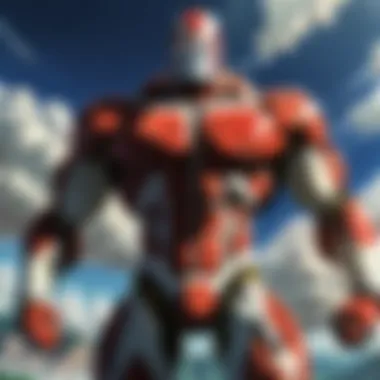
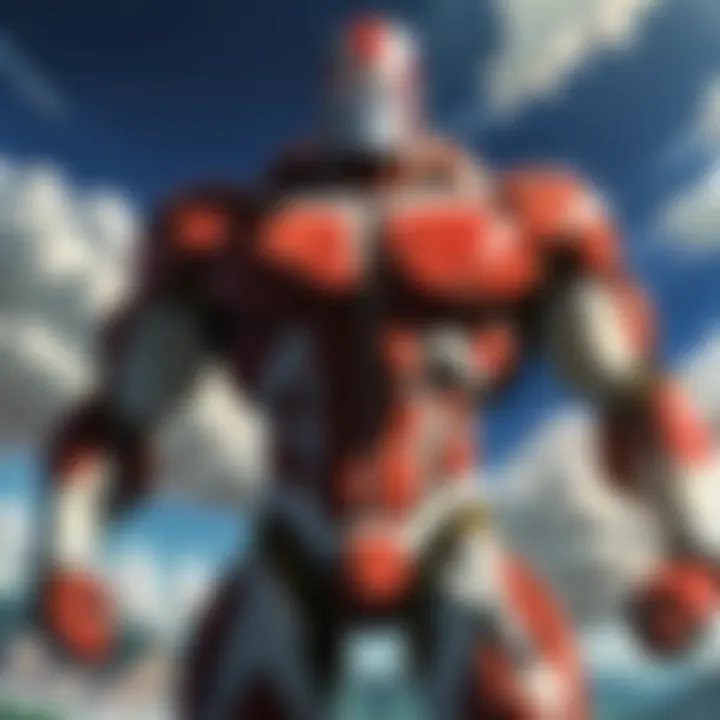
Intro
In the expansive universe of Attack on Titan, few elements captivate the imagination quite like the Titans. These gigantic humanoid beings are not merely antagonists; they embody the struggles and fears of humanity itself. Understanding the Titans requires us to take a closer look at their origins, capabilities, and the pivotal role they play throughout the storyline.
As we pull back the curtain, it becomes crucial to note that the Titans serve not only as brute forces of destruction but also as symbols of overarching themes like oppression, loss, and the fight for freedom. The series intricately ties the existence of these Titans to the very essence of humanity's survival. Let’s embark on this enlightening journey, dissecting the fascinating world of Titans and their significance within Attack on Titan.
Episode Reviews
Analyzing specific episodes of Attack on Titan reveals deep layers of conflict and character development tied directly to the Titans.
Summary of the Episode
Take, for example, the first season’s opening episode, where viewers are immediately thrust into a world terrorized by these immense creatures. A historic breach of Wall Maria marks a turning point, launching the storyline into a whirlwind of chaos, agony, and courage. The sheer terror depicted through the Titans plunging through the walls highlights the initial sense of hopelessness that pervades the narrative.
Analysis of Key Events
In later episodes, like the climactic confrontation of the Battle of Trost, the strategic moves of the characters are a direct response to Titan attacks. The display of teamwork, paired with the panic induced by Titan appearances, paints a vivid picture of the dire circumstances faced by humanity.
Discussion on Character Development
Central characters such as Eren Yeager undergo significant development as they grapple with the Titans' threat. Initially seen as a naive youth, Eren’s desire for vengeance morphs into a complex understanding of sacrifice. Each episode layers more into his character as battles ensue, revealing deeper motivations.
Highlight Memorable Moments
The series carefully crafts memorable moments around Titan encounters. The first time a Titan is defeated by the Three-Dimensional Maneuver Gear leaves the audience in awe. The combination of animation, coupled with an emotionally charged score, gives moments like this a lasting impact.
"Titans might represent our greatest fears, but confronting them exposes our greatest strengths."
The interplay between fear and bravery is a recurring theme, engaging viewers and keeping them invested in the characters' fates.
Character Spotlights
To understand the Titans fully, one must also understand the characters intertwined with these colossal beings.
Background Information on the Character
Eren Yeager stands at the forefront of this exploration. As a child, his life is shattered when Titans obliterate his hometown, motivating his quest for revenge and ultimately shaping his identity.
Personality Traits and Unique Quirks
Eren embodies the spirit of relentless pursuit. His tenacity sometimes borders on reckless abandon; he often acts before fully formulating a plan. This aspect of his personality is pivotal as it propels the narrative forward yet also serves as a source of inner conflict.
Role in the Storyline
Eren's transformation into a Titan himself adds a significant layer to the plot. This unexpected twist reshapes the audience's understanding of Titans, blurring the lines between monster and human.
Fan Theories and Speculations
The community around Attack on Titan is filled with speculations about the Titans' origins and Eren's fate. Fans postulate connections between different characters and the true history of Titans, further enriching the viewing experience.
Anime vs. Manga Comparison
Diving into the differences between the anime and manga unveils unique takes on character portrayals and plot details.
Plot Differences Between the Anime and Manga
While the anime is visually stunning, certain plot nuances are better explored in the Attack on Titan manga. For example, subtle character interactions may be more fleshed out in the source material, providing frequent readers with a more intricate understanding of their motivations and histories.
Art and Animation Quality
The anime adaptation boasts exceptional animation quality, especially during fight scenes between humans and Titans. The MAPPA studio has brought visceral energy to the screen, much lauded by fans worldwide.
Character Portrayal
Characters sometimes slightly differ in their portrayal between the two formats, where the manga's pacing allows for deeper introspection. Fans often note that this can alter their perceptions and attachment to these characters.
Fan Preferences and Opinions
Discussions on platforms like Reddit reveal a divide among fans; some prefer the raw storytelling of the manga, while others enjoy the cinematic flair of the anime. Each format offers unique insights and experiences.
Industry News and Updates
Keeping up with industry trends is just as vital in understanding the richness of the Attack on Titan universe as the story itself.
Announcements on Upcoming Releases
With the conclusion of the anime's final season nearing, excitement grows for any official announcements regarding additional content or spin-offs. Fans often scour news sites, wondering about potential continuations of the story that has captured hearts and minds alike.
Analysis of Industry Trends
The series has influenced a myriad of other anime, sparking interest in darker themes. Its impact can still be felt in recent titles, where the dynamics of humanity versus monstrous forces serve as a focal theme.
Insight into the Production Process
Understanding the hard work behind the scenes—storyboarding, character design, and voicing—adds depth to the experience. Following interviews and documentaries allows fans to see the passion that fuels each episode.
Top Lists
Creating lists in Attack on Titan fandoms fosters vibrant discussions, shaping preferences over beloved characters, episodes, and fights.
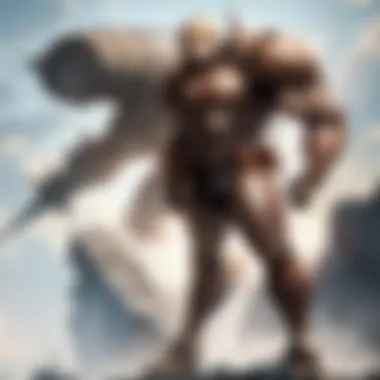
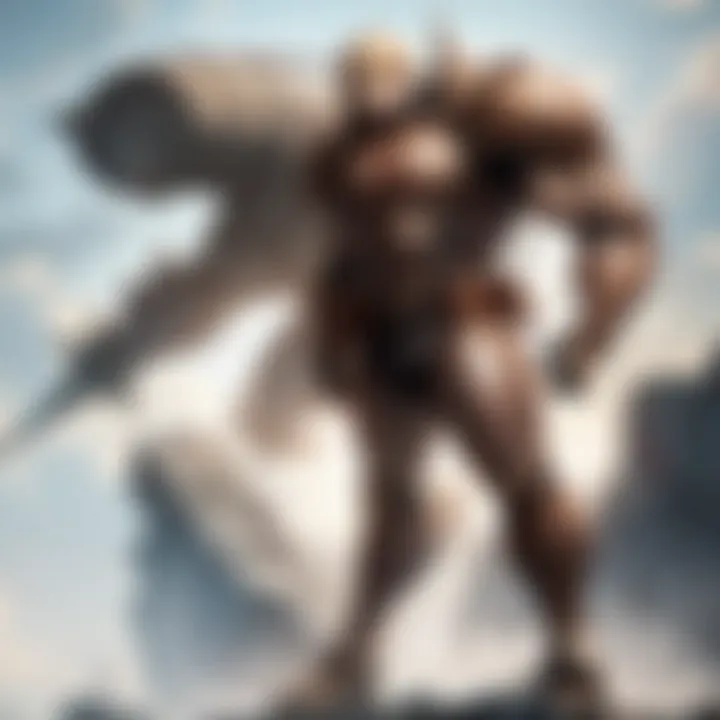
Ranking of Favorite Characters or Episodes
Fans often engage in debates about their favorite characters and the reasons behind their choices, leading to long threads of insightful discourse.
Compilation of Best Fight Scenes
The complexity of battles, not merely through strength but also strategy, is a recurrent topic. Lists detailing the best fight scenes are common, showcasing moments where sheer determination meets tactical brilliance.
Comparison of Different Genres Within Anime and Manga
The blend of genres in Attack on Titan—horror, drama, action—creates a rich tapestry, setting it apart from others. Fans appreciate dissecting how these genres meld seamlessly.
Audience Polls and Feedback
Engagement from the community through polls can significantly influence future content. What fans love and dislike guides narratives in ways that matter, shaping how stories unfold.
In concluding this exploration, we recognize the centrality of the Titans not just as physical threats but as poignant symbols weaving together the fabric of Attack on Titan. Understanding their nature and significance opens up a more profound appreciation of the series itself.
The Concept of Titans
Understanding the Titans in Attack on Titan involves delving into their profound significance within the series and the overarching themes presented by the creator, Hajime Isayama. At the heart of the story, Titans represent not just terrifying foes but also embody deeper meanings related to fear, freedom, and the struggle for survival. Exploring this concept allows audiences to grasp the layers of conflict and the intricate relationships between characters and the Titans themselves.
One might consider Titans as a reflection of humanity's existential challenges. They evoke feelings of vulnerability in a world where society continuously grapples with external threats. By viewing Titans through this lens, readers can better appreciate the philosophical questions about strength and weakness, the human condition, and the interplay between power and helplessness.
Importance of the Concept
The concept of Titans is crucial for several reasons:
- Narrative Structure: Titans serve as primary antagonists and drive the plot forward. Their actions force characters into conflict, leading to development and growth.
- Thematic Depth: The Titans' role in the narrative bridges between personal and societal struggle, stirring reflection on broader issues like oppression and identity within a confined world.
- Symbolic Dimensions: They symbolize the fears that plague humanity—both external and internal monsters that challenge one’s existence.
Through examining the origins and physiology of Titans, viewers gain insights into not only how they are constructed within the story but also the literary techniques employed to enhance the narrative’s emotional and intellectual impact.
Origins of the Titans
The origins of the Titans provide a rich backstory that connects to human history and mythology. Unlike typical monsters that spring from pure fiction, Titans have roots in a complex lore tied to the conflicts between humans. Initially, the series reveals that Titans were once humans who were transformed due to the power of the Founding Titan, a unique entity commanding mighty abilities.
The transformation into titans often happens due to an injection of a special fluid containing Titan DNA, leading to the loss of consciousness, where the former human intellect fades, replaced by the primal instincts of the titan form. This evolution adds a tragic dimension to the Titans, highlighting their connection to humanity rather than their separation from it. Moreover, the Titans can be seen as manifestations of the darkest sides of humanity—reflecting both self-destruction and tainted power wielded by an elite few.
The history surrounding the Titans serves as a warning against the perils of unchecked ambition and the moral compromises made to achieve power. In a way, they become poignant metaphors for the choices individuals make that lead to their downfall—a theme echoing throughout the series.
Titan Physiology
Delving into Titan physiology offers a fascinating glimpse into what makes these giants unique in both their function and their threat.
Titans vary in size, with most towering around three to fifteen meters tall, while a few, like the Colossal Titan, exceed even that, standing an astounding 60 meters tall. Their bodies are not bound by the physical laws that govern humans; Titans can endure fatal injuries that would easily kill a human. This resilience stems from their regenerative capabilities, which allow them to heal wounds quickly, making them formidable adversaries.
Another key aspect of Titan physiology is their lack of reproductive organs or traditional bodily functions. They possess a mysterious form of energy that powers them, leading to speculation on how Titan bodies exist without basic human characteristics. Lacking any human-like reasoning ability, they operate on instinct, driven by an insatiable hunger for human flesh.
Furthermore, there are unique configurations within Titan physiology that reveal their strengths and weaknesses:
- Skin: Titans' skin is deceptively tough yet can be pierced under certain conditions.
- Weak spot: Each Titan has a critical point at the nape of the neck, which is the key target for those who wish to take them down.
- Physical Structure: The skeletal and muscular structures allow for overhead movements and terrifying agility despite their massive sizes.
By understanding these characteristics, viewers realize that the Titans are not just mindless entities but represent a combination of horror and tragedy, echoing the struggles of the human spirit against overwhelming odds.
Types of Titans
The discussion of types of Titans is a cornerstone in grasping the intricate world of Attack on Titan. Each Titan type not only holds unique features but plays a pivotal role in shaping the plot and character dynamics. Understanding these types enriches the viewing experience and invites deeper reflections on the themes of conflict and survival. Their classifications hinge on physical characteristics and transformations, which subsequently define their behaviors and roles within society.
Pure Titans
Pure Titans are perhaps the most straightforward of the Titan classifications. These monstrous beings, towering over most humans, are naturally occurring. They are relentless in their hunger for human flesh, driven by an instinct to consume rather than any complex thought processes. The origins of Pure Titans tie closely to the transformation of human beings through a process involving the Titan serum. Once transformed, these individuals lose their human memories and ability to reason.
The most striking aspect of Pure Titans is their vulnerability. They lack the powers that other forms of Titans boast. Their significant physical strength and sheer size give them a terrifying presence, yet they can be dispatched with a well-placed strike to the nape of their neck. The grotesque appearance of Pure Titans—most notably their exaggerated facial features and fixed expressions—adds a layer of horror to them. They are not just foes; they symbolize humanity's deepest fears, turning the populace into prey rather than predators in their narrative.
Shifter Titans
Shifter Titans offer a juxtaposition to their Pure counterparts, as they embody something more complex. They arise when a human inherits the Titan power, allowing them to transform at will. This ability not only allows them to shift between human and Titan forms but also grants a range of unique powers that are unmatched by any Pure Titan. For instance, Shifters can maintain their human consciousness and tactical prowess even in their Titan forms, making them formidable opponents.
The strategic advantages of Shifter Titans are significant. They can utilize their size and strength in battles while retaining their intelligence and planning capabilities. This brings about a fascinating dynamic to the conflict landscape in Attack on Titan. Shifters represent the duality of power—a blessing and a curse, as characters often grapple with their human emotions while wielding such strength.
The Nine Titans
Among Shifter Titans, we find an elite group known as the Nine Titans, each with distinct abilities and historical weight. These Titans, which include the Founding Titan, Armored Titan, Colossal Titan, Beast Titan, and Female Titan, play crucial roles in the ongoing saga.
- Founding Titan: Central to the narrative, it has powers related to controlling other Titans and influencing Eldian history.
- Armored Titan: Known for its hardened skin, offering exceptional defense.
- Colossal Titan: This Titan's sheer size allows it to unleash devastating area attacks.
- Beast Titan: A clever beast whose ability includes throwing projectiles with remarkable precision.
- Female Titan: Known for its adaptability and powerful combat skills.
The Nine Titans are more than just combatants; they embody legacies tied to families and histories that catalyze the plot. The existence of these Titans raises essential questions about identity, freedom, and the moral implications of power in the Attack on Titan universe.
These Titans reflect not only the characters’ struggles but also represent themes of heritage and responsibility.
Understanding the different types of Titans therefore becomes indispensable for anyone who wishes to dive deep into this layered narrative. Each Titan type is imbued with symbolic meaning that amplifies the themes of conflict, survival, and the quest for freedom that defines the series.
The Abilities of the Titans
The abilities of Titans form the backbone of Attack on Titan, acting as the catalyst for significant plot developments and character arcs. These abilities are not merely a display of power; they serve as a reflection of the deeper themes within the series, including the struggle for survival, the consequences of war, and the ambivalence of humanity's fight against its own monsters. Understanding these abilities enriches the viewer’s perspective on the Titans and their impact on both the narrative and overall character development.
Physical Strength and Resilience
At their core, every Titan, regardless of type, embodies a level of physical strength that is staggering. This is not just about brute force; it encompasses endurance, speed, and a nearly supernatural level of resilience. For example, even after suffering severe injuries, Titans can often continue their rampage, showcasing a resilience that speaks to their near-immortality. This resilience serves multiple narrative functions, emphasizing the hopelessness of humanity's struggle against them.
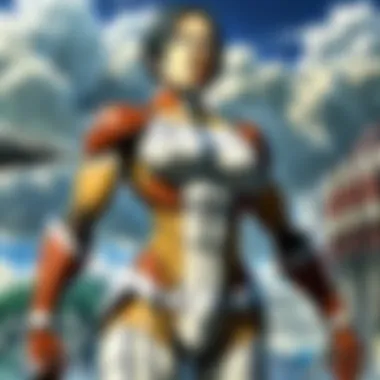
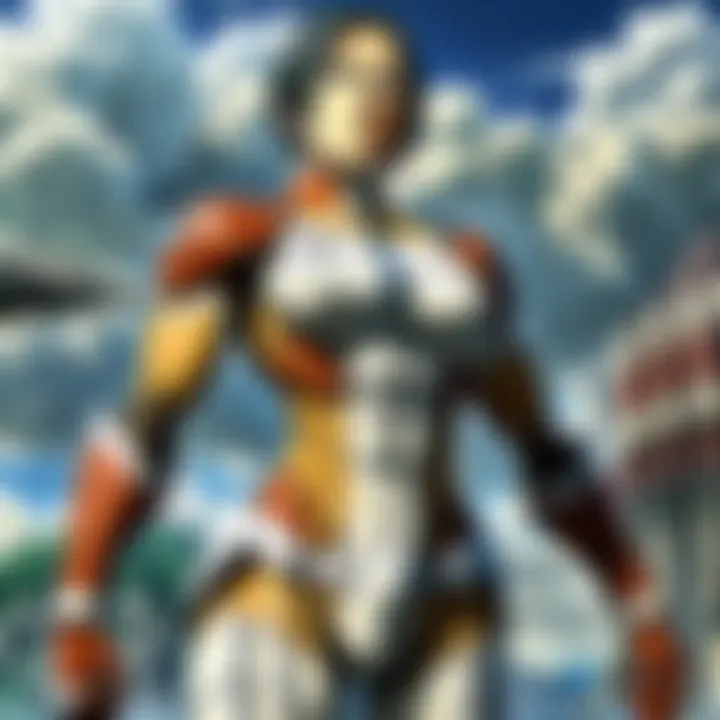
Additionally, the strength of Titans leads to intense confrontations, pushing human characters to their limits and thus making their victories feel earned rather than given. The Titans’ sheer size adds a unique dynamic to battles; tactical maneuvers need to be smarter and more calculated because a human soldier’s average strength pales in comparison to a Titan’s might. This imbalance is a continual reminder of the desperate plight of humanity, drawing viewers deeper into the thematic concerns of survival and conflict.
Unique Titan Powers
Each Titan possesses unique powers that set them apart, transforming them into iconic elements of the story. Here’s a closer look at some of these powers:
Founding Titan
The Founding Titan stands as a crucial pillar within the Titan lore. Its key characteristic lies in its ability to manipulate other Titans and even alter the memories of Eldians. This can be enormously beneficial; controlling Titans can shift the balance of power in conflicts , turning enemies into allies. However, the true power of the Founding Titan is only accessible under specific conditions, mainly when held by someone of royal blood, which presents a significant limitation. This duality of power reveals themes of fate and choice within the broader context of the series.
Armored Titan
The Armored Titan is notable for its ability to harden its skin, making it incredibly resistant to attacks. This ability makes it a formidable opponent in battles. The primary benefit here is its dual role as both a creator of destruction and a protective barrier for its allies. However, the hardening also limits the Titan's mobility; while it can endure many attacks, it sacrifices speed on the battlefield. This trade-off provides a fascinating commentary on strength versus agility, pushing viewers to ponder which qualities are more valuable in a fight.
Colossal Titan
The Colossal Titan is famed for its massive size, which is not only breathtaking but also destructive. Its ability to emit steam at high temperatures makes it a dangerous opponent in close combat. This feature allows it to create a temporary shield, preventing attacks while also causing damage to nearby enemies. However, its sheer size limits stealth and agility, making it vulnerable in certain scenarios. This gives the Colossal Titan a contrasting nature, embodying both awe-inspiring power and crippling vulnerability.
Beast Titan
The Beast Titan brings a unique twist to Titan abilities, combining both brute force and intelligence. Its ability to throw projectiles with pinpoint accuracy allows it to dominate while still engaging strategy. This strategic thinking contrasts sharply with the primarily instinctual nature of other Titans, emphasizing the nature of warfare and the need for intellect in survival. However, its size limits its close combat capabilities, creating a dependency on distance strategies that can be exploited by smart opponents.
Female Titan
The Female Titan possesses an interesting combination of physical prowess and agility. It retains the unique ability to harden portions of its body, allowing for defensive maneuvers. This adds versatility; it can engage in both offensive strikes and defensive tactics. Yet, this adaptability can sometimes be counterproductive, leading to an overestimation of its capabilities in challenging situations. The Female Titan thus echoes themes of identity and the multifaceted nature of power in the series.
"The layers of complexity in Titan abilities reflect the broader struggles of humanity. It's a constant dance between power and vulnerability, strength and strategy."
Combining these unique abilities paints a vivid portrait of what Titans represent, bringing the narrative threads closer together. The capabilities of Titans not only escalate the stakes of battle but also weave into the thematic fabric of Attack on Titan, making this exploration essential for a deeper understanding of the entire narrative.
Significant Titan Characters
In the rich tapestry of Attack on Titan, the Titan characters are more than just formidable forces of destruction; they symbolize the moral struggles and intricate choices faced by humanity. This nuanced portrayal of Titan characters elevates the series from a simple fight for survival to a deeply reflective narrative on identity, agency, and sacrifice within a brutal world. The examination of significant Titan characters such as Eren Yeager, Reiner Braun, Annie Leonhart, and Zeke Yeager offers insights into their motivations and the profound impact they have on the series' unfolding drama.
Eren Yeager
Eren Yeager serves as the central figure in the narrative, driving the story forward with his passionate desires and complex transformations. Initially introduced as a typical youth with aspirations of exploring the world beyond the walls, Eren's character arc delves into the existential complications that come with being endowed with Titan powers. As he gradually becomes aware of the weight of his abilities, his internal conflict between humanity’s survival and his personal vendetta against Titans unfolds dramatically.
His relationship with his friends, particularly Mikasa and Armin, highlights his deep-seated human connections, which are put to the test as he navigates his tumultuous destiny. Encountering moral dilemmas, Eren evolves from a hero to a more ambivalent figure, reflecting on themes of freedom and determinism. His ultimate decision to embrace the destructive potential of his Titan form raises questions about the cost of liberation and the nature of true freedom.
Reiner Braun
Reiner Braun embodies the dichotomy of loyalty and betrayal, making him a quintessentially complex Titan character. A soldier from Marley, his infiltration into the ranks of the Survey Corps leads to an existential struggle. Reiner's duality is encapsulated in his identity as the Armored Titan—an image of strength contrasting sharply with his internal turmoil.
His journey presents the idea of conflict between duty and personal agency, as Reiner wrestles with his overwhelming guilt and the consequences of his actions. The heaviness of his choices often leads to moments of vulnerability, which makes him a tragic character. The audience sees him grappling with his conscience, ultimately questioning whether he is a soldier or a monster.
Annie Leonhart
Annie Leonhart is both mysterious and formidable, a character wrapped in enigma. Her role as the Female Titan throws the narrative into disarray, creating tension and intrigue as her motivations remain shrouded in secrecy. Throughout the series, Annie is characterized by her cold detachment and poise, attributes that blur the lines between hero and villain.
However, as the story unfolds, glimpses of Annie's humanity seep through her tough exterior—particularly in her interactions with others. The contrast between her public persona and her private fears underscores her internal conflicts. This complexity invites the audience to ponder the consequences of choosing duty over personal desires, shedding light on Annie's true motivations as she seeks to understand her own being in a world that demands conformity.
Zeke Yeager
Zeke Yeager stands as a pivotal player in the saga, woven into the very fabric of the ongoing struggle between Marley and Eldia. Known as the Beast Titan, Zeke possesses abilities that drastically alter the dynamics of Titan warfare. His character adds layers of political intrigue and ethical ambiguity, often steering the narrative toward difficult discussions surrounding heritage and responsibility.
Zeke's background offers insight into his motives: raised under the pressure of expectations from both sides, he embodies the conflict of wanting to break the cycle of hatred and suffering. Yet, his path leads him to make harrowing choices that leave a lasting impact on both his allies and enemies. The exploration of his psyche provides a look at the broader implications of leadership and legacy, culminating in a character that is both revolutionary and tragic.
"In Attack on Titan, the Titans are not merely antagonists; they are reflections of the characters that wield them, revealing deeper truths about human nature."
Through the lens of these significant Titan characters, the series constructs a dialogue about identity, humanity, and morality. Each journey unfolds against the backdrop of an unforgiving world, richly contributing to a narrative that remains as engaging as it is thought-provoking.
The Role of Titans in the Narrative
The significance of Titans in the narrative of Attack on Titan goes far beyond their intimidating appearances and colossal stature. These beings are not just antagonists; they symbolize various themes and conflicts that permeate the story. The presence of Titans plays a crucial role in the overall development of the plot and the moral dilemmas faced by the characters. Their representation of fear, oppression, and the struggle for freedom serves to reflect the deeper societal issues within the narrative, making them integral to the storyline and its meaning.
Titans as Symbols
Titans are powerful symbols in Attack on Titan, representing the harsh realities of humanity’s existence and the fears that accompany society’s struggle for survival. At first glance, they embody brute force and chaos, but a closer examination reveals their multifaceted nature. The Titans can be seen as analogies for several key aspects of the human experience:
- Fear of the Unknown: The Titans provoke fear and uncertainty, reflecting humanity's dread of what lies beyond their walls, both literal and metaphorical.
- Oppression and Control: They symbolize the oppressive structures of society, where the citizens of humans live in a state of constant dread under an authoritarian regime.
- The Loss of Humanity: The transformation into titans hints at the potential loss of one’s humanity, representing the personal struggles against extreme circumstances that lead to alienation and despair.
As the story unfolds, these Titans become more than just monsters; they incite introspection and critical thinking regarding the nature of freedom, control, and what it means to truly live.
Conflict and Resolutions
The narrative is laced with conflicts stemming from the Titans’ existence, and this exploration of conflicts leads to potential resolutions that are often complex and multifaceted. Initial encounters with Titans drive the plot forward, bringing characters face to face with their greatest fears and challenges. Here are some pivotal aspects:
- Human vs. Titan Conflict: The battles between the Survey Corps and Titans showcase humanity’s resilience and the relentless fight for survival. This ongoing conflict compels characters to evolve, forcing them to confront both their external enemies and their internal struggles.
- Moral Ambiguity: As the series progresses, distinctions blur between the Titans and humans. Characters like Eren Yeager grapple with their identity and purpose, stirring debates about morality and justice. The evolving relationship between the Titans and their human counterparts adds a layer of complexity to traditional notions of good and evil.
- Resolution through Understanding: Ultimately, some of the conflicts are resolved not through violence but through understanding and empathy. As certain characters discover the origins and motives of the Titans, they begin to understand the shared struggles that connect them. This understanding allows for a deeper exploration of reconciliation and the potential for change.
In essence, Titans play an essential role in the narrative framework of Attack on Titan. They serve as both external threats and catalysts for character development and thematic exploration. Through their symbolic nature and the conflicts they engender, the series invites its audience to reflect on the nature of humanity, freedom, and the sacrifices made in the pursuit of survival.
"The Titans are not just monsters; they are a reflection of humanity’s darkest fears and deepest desires."
Exploring the role of Titans reveals the intricate connections between character, theme, and conflict, ultimately contributing to a narrative rich with depth and meaning.
Humanity's Struggle Against Titans
In Attack on Titan, the struggle between humanity and the Titans represents much more than simple survival; it illustrates a deep-rooted battle for identity, freedom, and the very essence of what it means to be human. This confrontation serves as a pivotal element of the narrative, offering layers upon layers of meaning as characters grapple with overwhelming odds and intense moral dilemmas.
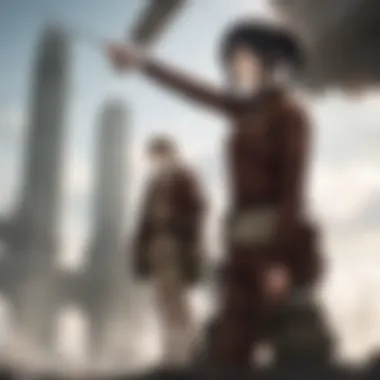
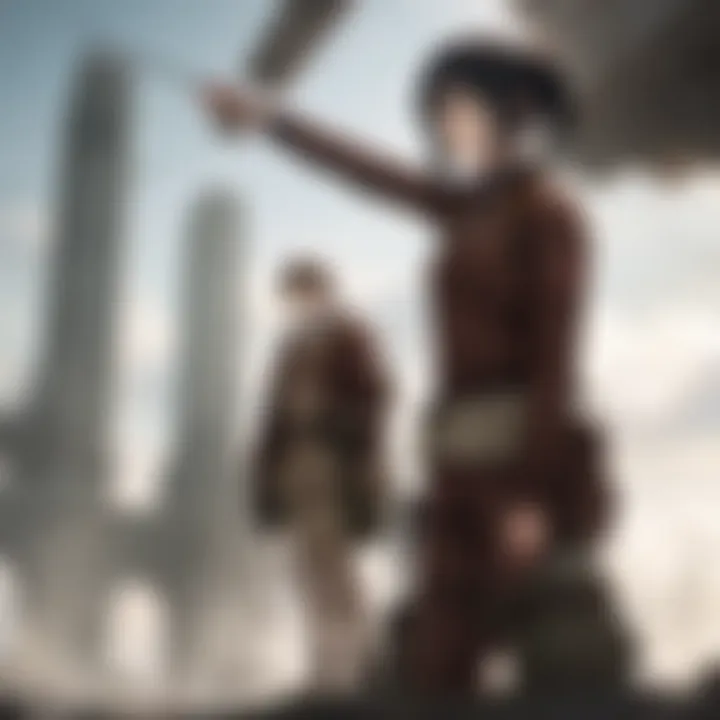
The Military and Titan Hunters
The military’s role, primarily embodied by the Survey Corps, is significant. These brave souls are tasked with the daunting job of confronting Titans head-on, often at the expense of their lives. Their courage is not just physical; it also embodies a fierce desire for freedom from oppression. Each battle against the Titans reflects a larger quest for humanity's survival and dignity within their confined walls.
The hierarchy within the military exhibits varied perspectives on how best to combat these threats, creating a rich tapestry of conflict and collaboration. The military functions not just as a means of fighting Titans, but as a societal structure that highlights human dynamics in extreme situations. Characters like Erwin Smith and Captain Levi bring different leadership styles to the forefront, forging pathways through chaos with calculated strategies and unwavering resolve.
Moreover, Titan hunters, who are often civilians, showcase resilience that is equally compelling. Many of them have personal stakes in the fight; motivation springs from loss and vengeance. They signify that while the threat may seem insurmountable, the human spirit can forge unexpected alliances and ignite courageous acts in response to tyranny. These layers of human emotion and conflict enrich the story and draw viewers deeper into the narrative.
Strategies for Survival
Survival in Attack on Titan hinges on innovation and adaptability. The recurring theme of humanity's struggle comes alive through the strategies employed against the Titans.
- Formation Tactics: In the face of Titans, military formations become crucial. Strategies based on teamwork allow humans to exploit Titan weaknesses.
- Mobility Gear: The Vertical Maneuvering Equipment has redefined engagement tactics, granting humans the upper hand in speed and maneuverability. This technology represents a blend of human ingenuity and desperation, fundamentally changing the fight.
- Spearheads of Knowledge: Understanding Titan biology plays a significant role in survival—knowing how to eliminate a Titan effectively can be the difference between life and death. The importance of intelligence gathering, whether through scouting or using informants, becomes apparent.
This adaptability highlights not just physical warfare but a war on many fronts—psychological warfare plays its part too. The very essence of hope makes a compelling weapon, often being the motivator for soldiers to push forward against overwhelming pain and loss. The struggle isn't just outside; it's within.
“Attack on Titan” captures the relentless human spirit through battles that are not simply about survival but about reclaiming one's right to exist. This reveals a raw determination and the universality of human experience.
The Evolution of Titan Lore
The evolution of Titan lore in Attack on Titan serves as a foundational pillar in understanding both the Titans and the broader narrative that envelops them. As the series progresses, the lore surrounding these giants not only reflects the complex history of the world but also underscores the philosophical questions about humanity, power, and survival. This evolution reveals how Titans, initially perceived as mere threats to human existence, gradually transform into multi-dimensional symbols that embody broader themes of conflict and identity.
By tracing the roots of Titan origins and their intertwining with human history, we uncover layers of meaning that elevate the Titans from grotesque monsters to intricate narratives that challenge our perceptions of good and evil. Discussions about Titan history can offer rich insights into not just the backstory but the present implications for the characters and the overall struggle depicted in the series.
Historical Context
In the early days of the Attack on Titan saga, Titans were shrouded in mystery, perceived purely as terrifying foes to be vanquished. Events unfolded in a fairly linear manner, giving the initial impression that Titans existed solely for human eradication. However, it soon became evident that the series delves into a much deeper narrative.
The lore begins to expand significantly with the introduction of the Marleyan perspective, which reshapes the understanding of Titans. Significant timelines, such as the Great Titan War, introduce a shifting narrative where Titans are not only viewed as the enemy but also as victims of their own chaotic history. Understanding this complexity allows fans to appreciate the duality of Titans: as harbingers of despair and symbols of the cycle of trauma that plagues both humans and Titans alike.
From the origins tied to Ymir Fritz to the societal rifts exemplified through the Marleyan conflict, the historical context of Titan lore becomes essential in forming the character motivations and larger ideas presented in the series.
Impact on the Current State
The impact of this evolving lore translates directly into the urgency and stakes seen in Attack on Titan's current state. As the series reaches critical plot points, the foundational elements of Titan history shape the actions and beliefs of key characters, influencing their trajectories significantly.
For instance, Eren Yeager's growth from a frightened boy to a morally ambiguous figure is steeped in the unfolding Titan lore. His understanding of the implications tied to his Titan powers, the history of conflict between Marley and Eldia, and the weight of Ymir Fritz's legacy inform his decisions and the existential dilemmas faced by his companions.
Moreover, the revelations about the Titan origins and their purpose illuminate the broader themes of freedom versus oppression. Fans are left grappling with complex moral questions, such as whether the cycle of hatred can ever be broken, and understanding the Titans' evolution plays a crucial role in this discourse.
"The Titans' lore serves not only as a backdrop but as a driving force shaping the very future of humanity in the world of Attack on Titan."
In summary, the evolution of Titan lore takes players beyond the surface of horror and reveals a tapestry of human emotions and historical consequences that define the narrative. This exploration provides fans with profound insights into the intricacies of the story, showcasing that there’s always more beneath the skin of these towering giants.
Fandom Perspectives
The realm of Attack on Titan extends far beyond its narratives and visuals; it is deeply entwined with its fandom. Understanding the perspectives of the fans not only enriches the experience of following the story but also uncovers the various layers of cultural and emotional resonance present in the series. Fans are more than just passive viewers; they actively engage with the content, creating a community that thrives on speculation, interpretation, and enthusiasm.
The community reflects a range of values and interests, from the appreciation of intricate artwork to the exploration of complex character arcs. This vibrant ecosystem fosters creativity and dialogue, resulting in an array of fan-made content, including art, cosplay, fan fiction, and animated videos. Such contributions enable the story of Attack on Titan to transcend its original format and become a more extensive cultural phenomenon.
Moreover, the fandom serves as a mirror, illustrating the wider implications of the themes presented in the series. With gripping narratives of survival, morality, and the struggle against oppression, fans often draw parallels to real-world issues, thus broadening the impact of the narrative beyond mere entertainment.
"Fandom transforms the act of watching into a communal experience, allowing individuals to find their voices amid the broader narrative."
Cultural Significance
The cultural significance of Attack on Titan cannot be understated. It resonates with various audiences, both in Japan and globally, thanks to its profound themes that delve into societal fears, such as conflict, survival, and the ethical complexities faced by humanity. This series has sparked conversations about freedom, oppression, and the cycle of violence, which in turn finds its echoes within current sociopolitical climates.
Fans often engage in discussions that unravel the series' commentary on power dynamics and moral dilemmas. Such dialogues contribute to the prevailing experiences of cultural exchange, further rooting Attack on Titan into the fabric of contemporary society.
The fandom also emphasizes the importance of storytelling in preserving cultural narratives. By carrying forward the story through various means—be it discussions on Reddit, fan meetups on platforms like Facebook, or shorthand conversations in everyday life—fans breathe life into the series, ensuring its relevance for generations to come.
Theories and Speculations
Theories and speculations among fans breathe an air of excitement into Attack on Titan. Engaging in speculation about future plot developments, character arcs, or hidden meanings sparks fervor among enthusiasts. This collective brainstorming creates an environment where every detail is examined, and every dialogue dissected for clues.
- Character Relationships: Fans consistently delve into who is connected to whom and examine the motivations behind character alliances and betrayals. This analysis often leads to theories about future betrayals and sacrifices.
- Titan Origins: Many enthusiasts speculate on the origins of the Titans and the historical implications depicted in the series. Questions arise like What led to the creation of the Titans? or What does the true history of Eldia entail?
- Endgame Scenarios: Among the most heated debates is what the ultimate conclusion of the series may look like. Many fan theories suggest various potential endings that could align with or diverge from the broader themes of war, redemption, and humanity's cyclical struggles.
These discussions not only showcase the intelligence and creativity of the fanbase but also highlight Attack on Titan's intricate storytelling, which inspires a rich tapestry of thought-provoking hypotheses.
In sum, the fandom surrounding Attack on Titan acts as both a conduit for cultural analysis and a breeding ground for imaginative interpretations, keeping the Titan lore alive and ensuring that its legacy continues to thrive.
The Future of Titans
The examination of The Future of Titans is imperative for anyone keen on exploring the layered complexities of Attack on Titan. What happens to the Titans as the narrative progresses can shape not just the plot but the very fabric of the world within which these beings exist. Their existence doesn’t stand alone; it intertwines with the histories, struggles, and evolving philosophies of the characters. This section sheds light on potential developments that may emerge, and considers their lasting effects on the realm of storytelling, especially within anime and manga culture.
Potential Developments
As the series unfolds, numerous potential threads could be tugged at regarding the Titans. The introduction of unsolved mysteries around Titan powers and their origins can offer fresh ground for narrative exploration. Among the ideas that might take root are:
- The Emergence of New Titans: Given that the lore hints at buried secrets, new Titans may emerge, each with unique traits and powers. This has huge implications for the balance of power, leading to unforeseen conflicts.
- Technological Interference: What if humanity advances to the point where technology can counter or even neutralize Titan powers? The use of advanced weaponry or methods could create a dystopian shift in the power dynamics between Titans and humans.
- Philosophical Ramifications: The series could delve into the moral implications of Titans’ existence and their relationship with humanity. Discussions on morality, identity, and purpose could reshape character arcs, radically altering perceptions of Titans from mere monsters to complex entities worthy of empathy.
Engaging with these developments would deepen the thematic richness of Attack on Titan, potentially offering fans a more multi-faceted view of these colossal beings.
Legacy of Titans in Popular Culture
The legacy of Titans in popular culture cannot be understated; they haunt the memories of both fans and casual viewers alike. These creatures came to symbolize various societal themes, like fear, the unknown, and humanity’s struggle against nature. Attack on Titan has left an indelible mark on anime and manga, paving ways for new genres and themes that echo its essence.
- Cultural References: Many shows have borrowed the concept of gigantic creatures representing threats to humanity’s existence, often using them as metaphors for larger societal issues such as war, oppression, or ecological crises.
- Creative Inspiration: The Titans have sparked numerous fan art, series discussions, and even cosplays, blending the lines between creator and consumer. Their distinct designs have inspired countless stories across various media, resulting in a rich tapestry of interpretations.
- Academic Interest: Scholars and enthusiasts alike delve into the intricacies of Titans, analyzing their role not just as antagonists but as symbols rich in meaning and commentary on human nature. Articles and essays have proliferated, exploring the socio-political ramifications of Titans in the narrative.
As Attack on Titan continues to resonate with audiences, its legacy enriches the landscape of storytelling, serving as a powerful reminder of how fiction can mirror and influence reality.
"Titans are not merely monsters; they are reflections of humanity’s deepest fears and struggles, challenging our understanding of strength and weakness."
In examining The Future of Titans, we glimpse a rich potential for narrative evolution and cultural reflection. The journey, regardless of where it might lead, ensures that Titans will remain a captivating subject in discussing the intersection of storytelling and societal introspection.







